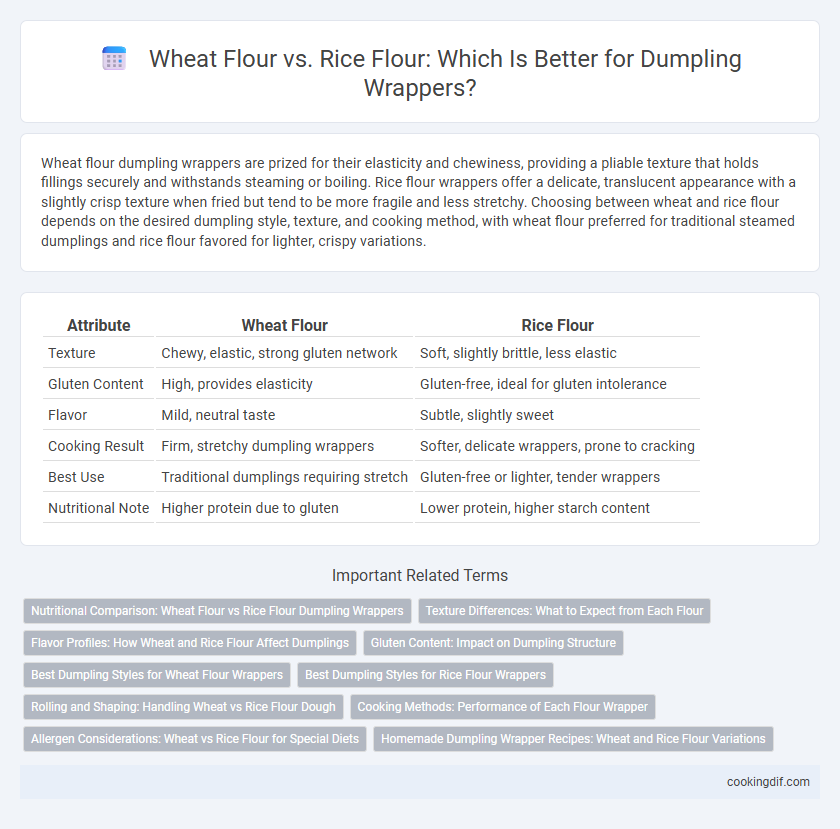Wheat flour dumpling wrappers are prized for their elasticity and chewiness, providing a pliable texture that holds fillings securely and withstands steaming or boiling. Rice flour wrappers offer a delicate, translucent appearance with a slightly crisp texture when fried but tend to be more fragile and less stretchy. Choosing between wheat and rice flour depends on the desired dumpling style, texture, and cooking method, with wheat flour preferred for traditional steamed dumplings and rice flour favored for lighter, crispy variations.
Table of Comparison
| Attribute | Wheat Flour | Rice Flour |
|---|---|---|
| Texture | Chewy, elastic, strong gluten network | Soft, slightly brittle, less elastic |
| Gluten Content | High, provides elasticity | Gluten-free, ideal for gluten intolerance |
| Flavor | Mild, neutral taste | Subtle, slightly sweet |
| Cooking Result | Firm, stretchy dumpling wrappers | Softer, delicate wrappers, prone to cracking |
| Best Use | Traditional dumplings requiring stretch | Gluten-free or lighter, tender wrappers |
| Nutritional Note | Higher protein due to gluten | Lower protein, higher starch content |
Nutritional Comparison: Wheat Flour vs Rice Flour Dumpling Wrappers
Wheat flour dumpling wrappers contain higher protein and fiber content, providing more sustained energy and better digestion support compared to rice flour wrappers. Rice flour wraps are gluten-free, making them suitable for individuals with gluten intolerance or celiac disease, but they tend to have a higher glycemic index. Both flours offer distinct nutritional profiles, where wheat flour emphasizes complex carbohydrates and essential nutrients, while rice flour caters to gluten-sensitive diets with lighter texture and faster digestion.
Texture Differences: What to Expect from Each Flour
Wheat flour creates dumpling wrappers with a chewy and elastic texture due to its higher gluten content, making them ideal for boiling or pan-frying. Rice flour produces wrappers that are more tender and slightly brittle, resulting in a delicate bite often preferred for steaming or frying in crispy applications. Choosing between wheat and rice flour significantly impacts the dumpling's mouthfeel and cooking method suitability.
Flavor Profiles: How Wheat and Rice Flour Affect Dumplings
Wheat flour creates dumpling wrappers with a chewy, elastic texture and a slightly nutty flavor that enhances savory fillings. Rice flour results in a delicate, tender wrapper with a subtle, neutral taste that highlights the filling's natural flavors. The choice between wheat and rice flour significantly influences the overall flavor profile and mouthfeel of dumplings.
Gluten Content: Impact on Dumpling Structure
Wheat flour contains a high gluten content, which provides elasticity and strength, resulting in a chewy and durable dumpling wrapper that holds fillings securely during cooking. Rice flour is gluten-free, producing a more delicate and brittle wrapper that tends to be softer but less elastic, often leading to wrappers that can easily tear or break apart. The choice between wheat and rice flour significantly affects dumpling structure, with gluten-rich wheat flour offering better stretch and resilience compared to the fragile texture of rice flour-based wrappers.
Best Dumpling Styles for Wheat Flour Wrappers
Wheat flour wrappers are ideal for traditional Chinese dumplings like jiaozi and potstickers due to their elasticity and ability to hold fillings without breaking. The gluten content in wheat flour provides a chewy texture that complements savory ingredients, making it preferable for boiled, steamed, or pan-fried dumplings. Styles such as Northern Chinese jiaozi and Japanese gyoza predominantly use wheat flour wrappers to achieve their characteristic tender yet resilient skins.
Best Dumpling Styles for Rice Flour Wrappers
Rice flour dumpling wrappers excel in recipes like Cantonese char siu bao and Vietnamese banh bot loc, where a translucent, chewy texture is desired. Unlike wheat flour wrappers, rice flour creates a delicate, slightly sticky exterior that enhances fillings without overpowering them. This type of wrapper is ideal for steaming or boiling methods that preserve the dumpling's soft, elastic consistency.
Rolling and Shaping: Handling Wheat vs Rice Flour Dough
Wheat flour dough for dumpling wrappers offers greater elasticity and strength, making it easier to roll thinly and shape without tearing. Rice flour dough tends to be more fragile and less stretchy, requiring gentler handling and thicker rolling to prevent cracking. The gluten content in wheat flour provides the necessary pliability, whereas the absence of gluten in rice flour results in a delicate texture that demands careful manipulation during the dumpling-making process.
Cooking Methods: Performance of Each Flour Wrapper
Wheat flour dumpling wrappers exhibit excellent elasticity and strength, making them ideal for boiling, steaming, and pan-frying without tearing or becoming overly soft. Rice flour wrappers, often used in gluten-free recipes, provide a delicate, chewy texture that is best suited for steaming, as they can become brittle or fall apart during frying or boiling. The choice of flour significantly impacts the wrapper's performance in various cooking methods, influencing texture, durability, and overall dish quality.
Allergen Considerations: Wheat vs Rice Flour for Special Diets
Wheat flour contains gluten, a common allergen that can trigger reactions in individuals with celiac disease or gluten sensitivity, making it unsuitable for special diets requiring gluten-free options. Rice flour, naturally gluten-free, serves as an excellent alternative for dumpling wrappers, accommodating those with wheat allergies or gluten intolerance. Selecting rice flour conserves the texture and pliability needed for dumpling wrappers while ensuring allergen-free preparation for sensitive diets.
Homemade Dumpling Wrapper Recipes: Wheat and Rice Flour Variations
Wheat flour dumpling wrappers offer a chewy texture and strong elasticity, making them ideal for traditional boiled or steamed dumplings, while rice flour wrappers provide a delicate, slightly translucent finish with a softer bite, suitable for gluten-free variations. Homemade dumpling wrapper recipes using wheat flour often include water and sometimes egg for added elasticity, whereas rice flour recipes typically combine rice flour and tapioca starch to improve flexibility and prevent cracking. Choosing between wheat and rice flour wrappers depends on texture preference and dietary needs, with wheat flour delivering a classic robust structure and rice flour catering to light, tender dumpling skins.
Wheat flour vs Rice flour for dumpling wrapper Infographic

 cookingdif.com
cookingdif.com